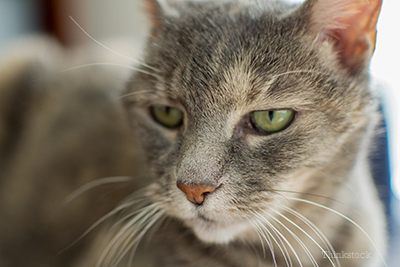
What is amyloidosis?
When cellular proteins form into folded sheets, instead of their correct three-dimensional shapes, amyloidosis occurs. This abnormal protein cannot be dissolved (insoluble) and it is resistant to normal digestion and breakdown. When deposited into different tissues/organs in the body, it is called amyloid1; it causes damage to, and displacement of, the normal cells. Minor, asymptomatic deposits of amyloid can occur with age. But extensive amyloidosis can cause significant and sometimes fatal disease1.
What causes amyloidosis in cats?
Usually, amyloid originates from a protein that is formed in response to inflammation. Any condition that causes severe inflammation can trigger the deposition of the abnormal proteins, including1:
- Chronic inflammatory disease
- Chronic infections
- Cancer
This spontaneous development of amyloidosis is a relatively unusual disorder in cats in general; however, it does occur as a genetic disorder in Abyssinian, Siamese and Oriental shorthair breeds, says DVM360.
Signs that your cat has amyloidosis
Remember that the amyloid deposits can occur in any location in the body–sometimes locally, in just one place, and sometimes more systemically. In small amounts, no damage occurs and no disease is apparent. It is only when the deposits interfere with normal organ function that clinical symptoms appear, and then they are related to the failure of the specific affected organ system2:
Diagnosing amyloidosis in cats
Your veterinarian will first diagnose your cat with a tissue specific disease or disorder and will then have to determine that the problem is the result of amyloidosis, which can be very difficult.
According to DVM360, affected Siamese and Oriental shorthair cats that deposit amyloid in their livers sometimes present with acute, internal, abdominal bleeding due to rupture of the lesions. Abyssinian cats with the disease can present at a very young age (typically between 1 and 5 years) with rapidly progressive kidney failure. Other cats that are only mildly affected can live long lives with no discernible, related illness.
The only way to definitively diagnosis the presence of amyloidosis is to obtain biopsy samples of the affected tissues for microscopic review with special stains.
Treating amyloidosis in cats
Unfortunately, there is no specific, proven treatment for amyloidosis and therefore no cure. Since there is no way to stop the abnormal folding during protein production and no way to dissolve or breakdown the already formed protein sheets, treatment is typically directed at the effects of any resultant organ dysfunction. When appropriate, trying to remove the source of inflammation to slow down any further amyloid deposition will also be important, thus slowing down the progression of the disease.
If you have any questions or concerns, you should always visit or call your veterinarian -- they are your best resource to ensure the health and well-being of your pets.
Resources:
- "Overview of Amyloidoses." Merck Veterinary Manual. MERCK, 04 Sept. 2015.
- "Amyloidosis." Vetbook. University of Sydney, Web. 04 Sept. 2015.
